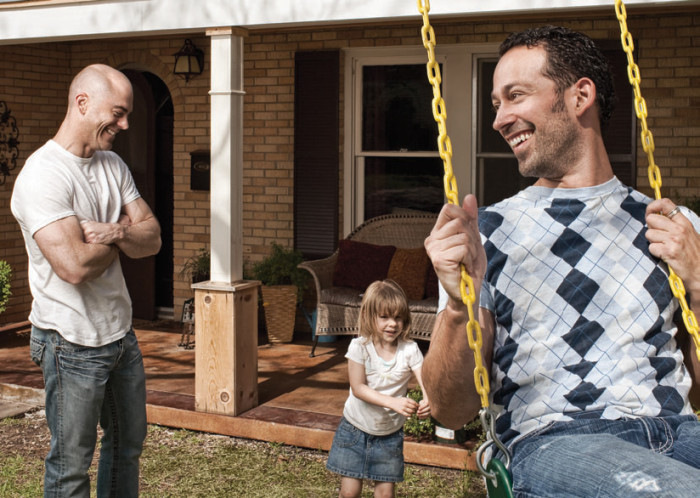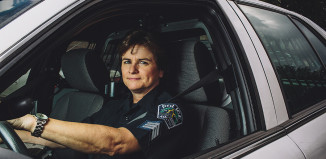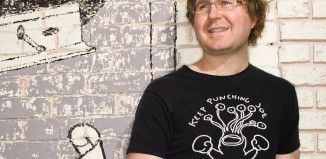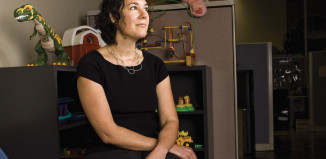Paloma Lasavilla approaches her Daddy’s new downtown apartment with the curiosity of any five-year-old. The little girl, all smiles, questions and blonde locks, has a few loves in her life right now: Chocolate cake, her new Lab puppy Miah, and of course her Daddy and Papa.
But things have been different at home lately and Paloma is having to adjust. “Is this your new house Daddy?” she asks David Lasater as they walk up to the door. “No, this is Daddy and Paloma’s new house,” he replies. “You have two houses now, one with Papa and one with Daddy. You’re very lucky – a lot of little girls don’t have two houses.”
The idea of being a real estate magnate at five is just a bit thrilling perhaps. She enters the apartment and immediately begins running about to explore. Lasater tells her she needs to name the new house, and – after a brief dalliance with the name “Sally” – the two decide on “Daddy and Paloma’s Downtown Pad.” It’s also a time of adjustment for both Paloma’s parents, Lasater and Michael Villarroel. After 17 years together – six of those in dogged pursuit of bringing their daughter into the world – the couple recently decided they needed to end their relationship with one another. It wasn’t a decision arrived at lightly. Nor was it one they agonized over or put off for the sake of their family.
“We knew that if we didn’t feel we could make the relationship work, us staying together wasn’t fair to her and it wasn’t fair to us,” says Lasater.
But while their romantic relationship has ended, Villarroel and Lasater share another that’s just as important to them both: parenting Paloma. A few minutes spent with either man is all that’s needed to know unequivocally that she comes first in both their lives.
“No matter what’s happened with our relationship, our commitment to her hasn’t wavered, and it won’t,” says Villarroel. “We’re committed to this family, even if it looks different than we originally planned it.”
FINDING LOVE
They met at work – an operator services company in Tucson, Ariz. in 1991. Villarroel was originally from New York, Lasater from Kansas City; both had moved to Tucson as adolescents. Comparing notes later, it seemed their paths were destined to cross. Lasater’s sixth-grade girlfriend was also Villarroel’s ninth-grade girlfriend. They were on the same junior league baseball team at different times and their families had several mutual connections.
Working together, they quickly became friends. When Villarroel broke up with his boyfriend and was looking to share an apartment with a roommate, he asked Lasater.
“We were friends first, each of us trying to set the other up on dates,” Villarroel remembers with a laugh. “Eventually, it evolved into us being together.”
That evolution took about nine months. But from the beginning of the relationship in spring of 1992, there was an extreme connection.
 “We balanced each other so well,” says Villarroel. “We enjoyed talking; talking about our future, about our goals in life. …It brought our relationship to a different level of closeness and trust. We were a team set on creating this life for each other and supporting each other.”
“We balanced each other so well,” says Villarroel. “We enjoyed talking; talking about our future, about our goals in life. …It brought our relationship to a different level of closeness and trust. We were a team set on creating this life for each other and supporting each other.”
Still, Lasater was 21, Villarroel just 20, and young love never comes with instructions. When Lasater got the opportunity to move back to Kansas City for a job and a chance to finish college, he agonized over leaving Villarroel. The latter in turn tried his best to be supportive. They drove from Tucson to Kansas City and spent a last two weeks together before parting ways. Not long after Villarroel returned to Arizona, he got a call. “It was David, and he told me, ‘I made a mistake.’”
Villarroel sped up his own coursework to finish his degree three months faster than planned and moved to Kansas City in May 1993. The couple rented a cheap apartment in a rough section of town, allowing them to save money for a house. Life was good, friends and support were plentiful. Two years later they bought their first home, a fixer-upper they immediately set to work renovating. By 1996, their relationship stronger than ever, Lasater managed to shake his jitters over commitment and proposed to Villarroel with a picnic in their own backyard and vows he had written for them to exchange.
If having a same-sex commitment ceremony isn’t easy today, having one a decade-and-a-half ago in the Midwest was even harder. They were able to find a Unitarian minister who would perform the ceremony at their home. Finding invitations proved to be a bit more difficult (Villarroel tells a great story about a very confused stationary shop employee). But everyone around them pitched in. Lasater’s best friend ended up creating the invitations. Villarroel’s best friend handled the food. Another friend took the pictures.
Instead of a honeymoon, they sunk more money and time into their home. “That house was our first project together,” Villarroel says. “It kind of became a side thing for us. We renovated eight houses over the years – making each one our own. We were always a couple that kept things going: working full-time to put ourselves through school, redoing houses, training for a marathon. We always kept things exciting.”
CREATING A FAMILY
Still, all the races and the renovations couldn’t stop Villarroel from wishing something else was in his life – a child. “I had always wanted kids and David wasn’t really sure. So I had kind of resigned myself that I wasn’t going to. Not only because he wasn’t sure but because we were a gay couple. I didn’t really think that was a possibility.”
Until one morning, with the couple just waking up, Lasater turned to his partner and said simply, “I want to have kids.” Villarroel was taken aback and a bit incredulous. “I said ‘talk to me in a year, if you still want to have kids then, we’ll talk about it.’ Literally a year to the day later, he brought it up.”
Did it seem odd for the family and friends around them that they would want to have a child? After all, this was the nation’s Heartland in the mid-1990s. “We were surrounded by the kids in my family, we were always babysitting, even our friends had children who referred to us as uncles. I think everyone saw parenthood as the natural next step for us,” says Lasater.
Immediately the two began looking into adoption. However, it quickly became apparent that it wouldn’t be easy for a gay couple to adopt through traditional means. They were told by one agency that their homosexuality would be overlooked if they agreed to take a baby with AIDS – an option they contemplated but decided against, unsure they could handle the possibility the baby would die.
Next, they turned to the avenue of international adoption. But, as is still largely the practice, most countries would not allow a baby to go to an openly gay couple, leading many would-be-parents to deny their sexuality and the existence of their partner in order to make the process work.
“Our first encounter with discrimination didn’t happen until we tried to have a child,” says Lasater. “One of the things we said when we began the process was that we would never misrepresent ourselves or lie. We didn’t ever want to be called into question for having a child through unrespectable means.” That left one option: surrogacy. A good friend told the couple she would donate her eggs to them, but she had already had a rough pregnancy and couldn’t carry the baby. They began a search for a surrogate carrier.
“We found a clinic in Kansas City that was liberal and very excited that we were going to be the first male couple that they worked with,” says Villarroel. But first, the eggs had to be harvested – a surgical procedure. The conservative-leaning hospital that the clinic was affiliated with voiced opposition. The decision went all the way up to the hospital’s board, which rejected the case.
Three years into the process and feeling defeated, Lasater and Villarroel gave up for a few months. Until Lasater got a call one day from Microsoft Corp. asking if he’d be interested in moving to Seattle for a job.
“Before even considering what the position was or what it would do for my career, I looked into the surrogacy laws in Washington. They were favorable,” says Lasater. He quickly accepted.
“We had such a rich fulfilling life in Kansas City, surrounded by friends and support,” says Villarroel. “But we were so focused on having a child – that transcended everything else.”
The couple moved to Seattle in 2001 and immediately relaunched their research into gestational carriers. They learned that while Washington’s laws were favorable for surrogacy, California was the only state where the intended parents of a child conceived through surrogacy were that child’s legal parents. Therefore, both same-sex parents could be listed on their child’s birth certificate without the need for second-parent adoption.

The decision was made to get a surrogate in California. “At one point,” says Lasater, “we had a lawyer in Kansas City monitoring the laws there for us in case we went back, another lawyer in Washington where we lived, and a third California.”
Joining Microsoft would prove more useful than Lasater thought. Understanding that the couple was trying to have children via surrogacy, the company decided for the first time in its history to extend infertility benefits to a male couple. “It was an amazing gesture,” says Lasater. “Throughout the whole process there were amazing acts of kindness and generosity.”
WAITING ON A MIRACLE
Things seemed to be looking up, but the couple couldn’t have known how many more obstacles lay ahead. Deciding to go through a donor agency, they found an egg donor who provided them with 10 eggs. Lasater and Villarroel each fertilized several eggs and had the embryos implanted with a surrogate carrier in California. The transfer failed. So did several others, until doctors learned the carrier actually had a rare condition that was preventing her from getting pregnant.
Another surrogate was selected, but the transfers continued to fail. One attempt resulted in a pregnancy that ended in a miscarriage. With three mortgages on their home, credit cards maxed out, a car sold and debt totaling $140,000, Lasater and Villarroel were financial broke and emotionally crushed. They were done.
When the fertility doctor they had been working with through the years called, he wanted to know why they were giving up.
“He told us, ‘You guys have come this far, you can’t give up now,’” Lasater remembers. “We told him: ‘We’re broke, we can’t go on.’ So he said, ‘You know what, we’re doing one more, and I’ll take care of it.’”
The couple flew to San Diego to meet with their embryologist. With this their last chance, the risky decision was made to transfer all four of their remaining embryos into the surrogate, hoping that one would take. One did, and the first baby picture of Paloma is her at just eight cells.
In the end, it had taken Lasater and Villarroel six years to have a child. Seeing their interaction with their daughter, it doesn’t even make sense to ask if it was all worth it.
It happens every second of every day in every corner of this world: babies being born, each filled with all the potential of new life. Many are wanted and loved, while others are neglected and abused. So one has to ask if it’s not a cosmic injustice of immense proportions that women who don’t want babies accidentally get pregnant every day while people, straight and gay alike, struggle for years to have children themselves?
“There are so many people out there who take it for granted,” says Villarroel. “During all this, I would see news reports of child abuse cases, and it would really affect me. There are people that just don’t realize what a miracle, what a gift, it is to have a child.” But far from being bitter, the couple concentrated on being the best parents they could. It wasn’t easy without any other gay dads around them as role models. “We were definitely exposed, and we didn’t know what we didn’t know,” says Lasater.
So they made up for their lack of knowledge with tons of research. They learned they would need to be proactive with their daughter. To focus on the positives – ”Paloma has two daddies” instead of “Paloma doesn’t have a mommy.”
“We’re not activists by any means,” says Lasater. “But we’ve been very open about our situation. …Instead of just slipping her in to daycare and hoping no one finds out (that she’s the daughter of gay parents) we were very proactive. We had those discussions up front, with teachers and others who are around her, so that there wasn’t any insecurity or adversity that we didn’t know about.”
Like her unique last name, Paloma is the absolute combination of her parents. Watching her play, her adventurous spirit is evident – something she gets from Lasater who’s taken her on nature hikes and little explorations since she was just a few months old. From Villarroel, who has had a greater part of the caretaker role, she has learned the virtues of fairness and nurturing.
“She’s so confident,” says Lasater. “She’s always willing to take risks because she knows she has us to fall back on. We’re grateful for a lot of things, but one of them is that she has that confidence and is experiencing a little bit more of life than a lot of other five- year-old girls.”
MOVING TO AUSTIN
Though they loved Seattle, two careers and a lot of traffic meant Paloma was spending too much time in daycare. So when Lasater had a job opportunity in Austin, the couple looked into the local culture and – deciding it was favorable for their family – made the move to Texas. Villarroel became a stay-at-home dad. From the start, Lasater and Villarroel knew that their daughter would need female influences and role models in her life to give her the balance they could not. They found one of those influences in Courtney Hurst.
Hurst started working at Paloma’s Austin preschool in September 2007. “She was my favorite kid,” says Hurst. “She’s so outgoing and brilliant. Sassy, but so kind. I wanted to hang out with her all the time. I told David and Michael, ‘you have to let me babysit her.’”
Hurst indeed became Paloma’s de facto babysitter, friend and role model.
“David and Michael are just exceptional parents,” Hurst says. “They’re always developing and learning with her, no matter what they do. It’s always quality time. I tell them, ‘when I have kids I’m coming to you guys for advice.’”
And while she’s the princess for both her parents, she doesn’t get away with much. “They discipline her and she knows who’s boss, Hurst says. She knows respect, understands boundaries and being fair. She’s so well-rounded.”
In some ways, the family has been a learning experience for others. When they remodeled their house in the Rosedale neighborhood, contractors were in and out constantly for weeks. “They had never been around gay people with a child, and they would ask questions,” says Villarroel. “After a while, seeing our family dynamic, they were like ‘Wow, you guys are just like any other family.’ I think it made them pause.”
Participating in both straight and gay parenting groups, Lasater and Villarroel were a bit surprised to learn that the conversations were virtually the same. “Everyone wants to know that what their child is doing is normal, so that’s where a lot of the questions are focused: ‘Does your child do this?’” says Villarroel. “Those questions are the same whether the parents or straight or gay.”
UNCHARTERED TERRITORY
When Villarroel and Lasater decided they needed to seperate, they immediately began seeing a family counselor to make sure they were minimizing the effect on Paloma.
“We know that our breakup could easily run in conflict to the impact we want for her, so when this all began, we committed to each other to be open with what we’re feeling and to have frank conversations,” says Lasater.
That’s not always easy. While Lasater recently started a new job with an Austin technology company, Villarroel is being laid off from his position as an office manager with a local family business. He is looking in earnest for a new position in the area, but with jobs difficult to come by in the current economy, the situation demands that they face the possibility of a move.
In the meantime, their style of co-parenting might confound other parents that have broken up. They talk constantly with one another about Paloma, working as a team on everything from praise to punishment. And they continue to make Sunday nights family night, when they three of them do something together.
Hurst says it’s evident to anyone who knows them that Paloma is her parents’ top priority. “I think that’s highlighted in their breakup,” she says. “They’re doing everything they can to do what’s best for her, even when that’s a situation that might be uncomfortable for them.
” The two say they’re able to do that not just because of their love for Paloma, but because of their history together. “The thing that we have that a lot of others don’t is that our relationship was rooted in friendship,” says Lasater.
“I feel fortunate to have David in my life,” says Villarroel. “I don’t look back at the time we were together as wasted, or in a negative way at all.”
To be sure, there will be new and complicated avenues to negotiate, such as how to intro- duce another man that one or the other is dating to their daughter. At the moment, both men are trying to navigate a very different dating landscape than the one they left nearly two decades ago.
Asked if they’re at all concerned that situations like theirs might be seen as a set- back for gay parents, both say no. “We’re not different than any other couple, straight or gay, who have children and eventually break up,” says Villarroel. “Just because we’re not together any more doesn’t mean that gay people shouldn’t have children. The time that we spent together, those 17 years, those should count for something.”
Fraught with obstacles, their journey symbolizes the struggle many gay families face. Yet without that struggle, there wouldn’t be a little girl, sweet and smart, gifted with all the possibilities the world has to offer. Without that struggle, there wouldn’t be Paloma.




































